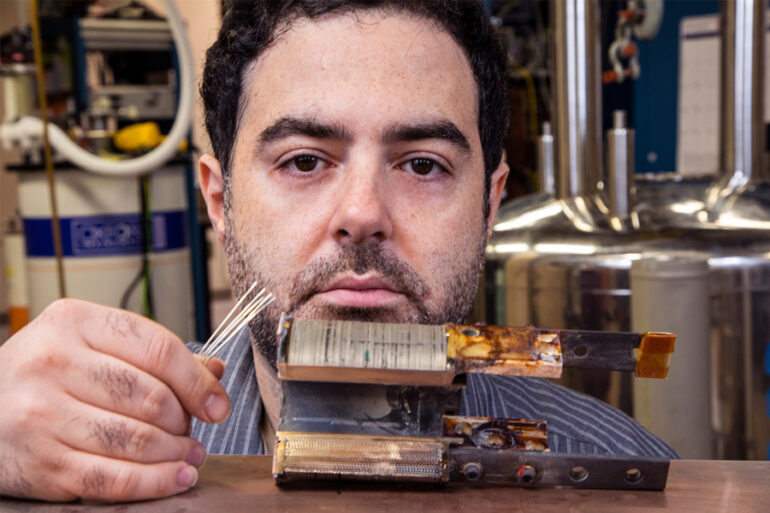The next generation of superconducting magnets has the potential to revolutionize fields such as energy storage, particle accelerators and medicine. The magic behind these tools lies in the high-temperature superconducting (HTS) wires that power them.
A FAMU-FSU College of Engineering team has discovered how to optimize a type of HTS wire, findings that may lead to new processing techniques to improve performance and lower costs. Their work was published in Physical Review Materials.
“There are three types of commercially available HTS wires that can power superconducting magnets,” said lead author Yavuz Oz, a postdoctoral researcher at the FSU-headquartered National High Magnetic Field Laboratory. “Two of these are made in rectangular form, and look like rolls of tape when wound up, and the third is round. We found that the round one is better for making magnets, and we want to find ways to optimize it even further.”
Oz is working with a team of researchers at the college, led by David Larbalestier, chief materials scientist at the National High Magnetic Field Laboratory and Marie Krafft Professor of Mechanical Engineering at the FAMU-FSU College of Engineering.
The team is specifically looking at the structure of Bi2Sr2Ca1Cu2Ox (Bi-2212) round wire, also known as BSCCO wire.
“We discovered that the way Bi-2212 wires are processed results in a special structure that is naturally well-connected,” Larbalestier said. “This is important because it allows us to focus on these beneficial aspects of the structure that we can optimize in production to significantly improve performance.”
The strongest magnets can have kilometers of superconducting wire powering them, and current travels through these materials. Some superconductors can have obstructed current paths because of badly connected crystals in the wire. These badly connected regions are costly and time-consuming to minimize. They are especially problematic in rectangular wires.
In contrast, high-performance Bi-2212 round wires are naturally free of these disconnected regions. Bi-2212 round wires are made by melting Bi-2212 powder inside a silver wire. When cooled slowly, the Bi-2212 powder crystallizes with well-textured grain colonies. This texture helps the wire achieve high critical current densities. The boundaries between the grains (called grain boundaries) in the underlying structure allow current to flow across a large surface area and this improves critical current capacity.
“We have the first experimental evidence for a theoretical model of current flow in Bi-2212 wires, called the Brick-Wall model,” Oz said. “It claims that electrical current prefers certain types of connections with large surface area to bypass electrically disconnected regions.”
The Bi-2212 round wires have a structure made of crystal grains that rotate slowly along the wire, giving the wire the same superconducting properties in all directions—an important advantage for building magnets. Other superconductor wires made in tape form are flat and have a uniform alignment of crystal grains. The way the grains align makes the tape develop different superconducting properties when measured in different directions, which makes it more difficult to design magnet coils.
The scientists experimented with Bi-2212 wires using a technique called “over-doping,” in which as much oxygen as possible is added into the wire. This technique greatly improves its electrical transport properties by increasing the critical current density, thus enhancing the magnetic field that can be generated to make the material perform better.
“Superconductors can only carry electrical current with perfect efficiency if nothing inside the material generates heat,” Oz said. “When a magnetic field penetrates the superconductor, it forms vortices. These vortices move around and generate heat when the material carries electrical current and can cause performance problems. By introducing the right kinds of impurities, we can ‘pin’ these vortices and prevent them from moving and generating heat.”
Strong vortex pinning is necessary for high, critical-current density and better performance. The team discovered that when over-doping is reversed (in other words, when oxygen is removed from the material), the inherently well-connected nature of Bi-2212 does not change. This finding helped the researchers narrow down the search for what makes Bi-2212 perform so well, with the goal of further improving its performance.
“We hope to successfully push Bi-2212 to full potential to become the prime high-temperature superconducting material of choice for use in high-field magnets,” Oz said.
By optimizing Bi-2212 round wires, the material may provide the necessary technology for a variety of important applications requiring high field magnets, such as an upgrade to the Large Hadron Collider at the European Organization for Nuclear Research, the world’s highest-energy particle collider.
More information:
Yavuz Oz et al, Conundrum of strongly coupled supercurrent flow in both under- and overdoped Bi-2212 round wires, Physical Review Materials (2021). DOI: 10.1103/PhysRevMaterials.5.074803
Provided by
Florida State University
Citation:
Researchers probe the performance of high-temperature superconductor (2021, December 16)



